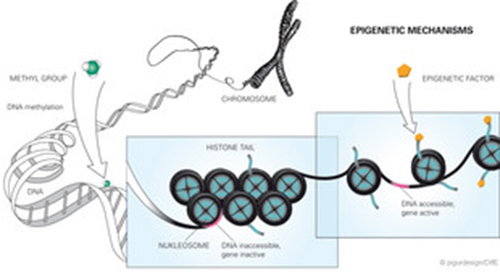
Source: DIfE
Small chemical changes in the DNA building blocks, which may be influenceable by lifestyle factors, can reduce the amount of IGFBP2. A DIfE / DZD research team has now reported in the journal Diabetes that these epigenetic changes increase the risk of type 2 diabetes. Moreover, people with high blood levels of the binding protein IGFBP2 are less likely to develop this metabolic disorder. The changes in the blood are already detectable a few years prior to the onset of the disease.
According to the German Diabetes Health Report 2018, more than 5.7 million people in Germany suffer from type 2 diabetes. The affected individuals react inadequately to the hormone insulin, which leads to elevated blood glucose levels. This in turn can lead to strokes, heart attacks, retinal damage, kidney damage and nerve disorders. Since the metabolic disease develops gradually, initial damage has usually already occurred at the time of diagnosis. “In the future, our findings may help to identify risk potentials for type 2 diabetes even earlier and help to counteract the disease with preventive measures,” said Professor Annette Schürmann, head of the Department of Experimental Diabetology at the German Institute of Human Nutrition Potsdam-Rehbruecke (DIfE) and speaker of the German Center for Diabetes Research (DZD).
Uncovering the molecular mechanisms
In addition to insulin, insulin-like growth factor 1 (IGF-1) is also involved in the metabolism of sugar and fat. The effect of this growth factor is weakened by binding to the IGF-binding protein 2 (IGFBP2). If the liver does not release enough IGFBP2 into the blood, the balance of the glucose and lipid metabolism may be disrupted. The research team led by Schürmann and Professor Matthias Schulze, head of the Department of Molecular Epidemiology at DIfE, therefore investigated how the diminished effect of the IGFBP2 gene could influence the development of type 2 diabetes.
Human studies show that people suffering from fatty liver produce and release less IGFBP2. Schürmann’s team observed similar effects in earlier mouse experiments, which showed that IGFBP2 levels were already reduced prior to the liver disease. This is due to the transfer of methyl groups at certain sites of the IGFBP2 DNA sequence, which inhibited the gene in the liver. These so-called epigenetic changes are caused, among other things, by lifestyle factors. Such modifications of the DNA in the IGFBP2 gene were also previously detected in blood cells of overweight people with impaired glucose tolerance.
Translational research from mouse to human studies
The interdisciplinary research team led by Schürmann and Schulze used findings from the clinic and laboratory to evaluate blood samples and data from the EPIC Potsdam Study. “This study is a good example of how translational research works: A clinical finding is taken up, analyzed mechanistically in the laboratory and finally examined in a population-wide study,” said Schürmann.
Recent analyses by the researchers indicate that inhibition of the IGFBP2 gene promotes type 2 diabetes. In addition, the team of scientists observed that leaner study participants and study participants with lower liver fat levels had higher concentrations of the protective binding protein in the blood. Higher plasma concentrations of IGFBP2 were associated with a lower risk of developing type 2 diabetes in subsequent years. “Our study confirms the hypothesis that the IGF-1 signaling pathway also plays an important role in the development of type 2 diabetes in humans,” added Dr. Clemens Wittenbecher, research associate in the Department of Molecular Epidemiology at DIfE and first author of the study.
Filed Under: Drug Discovery and Development




